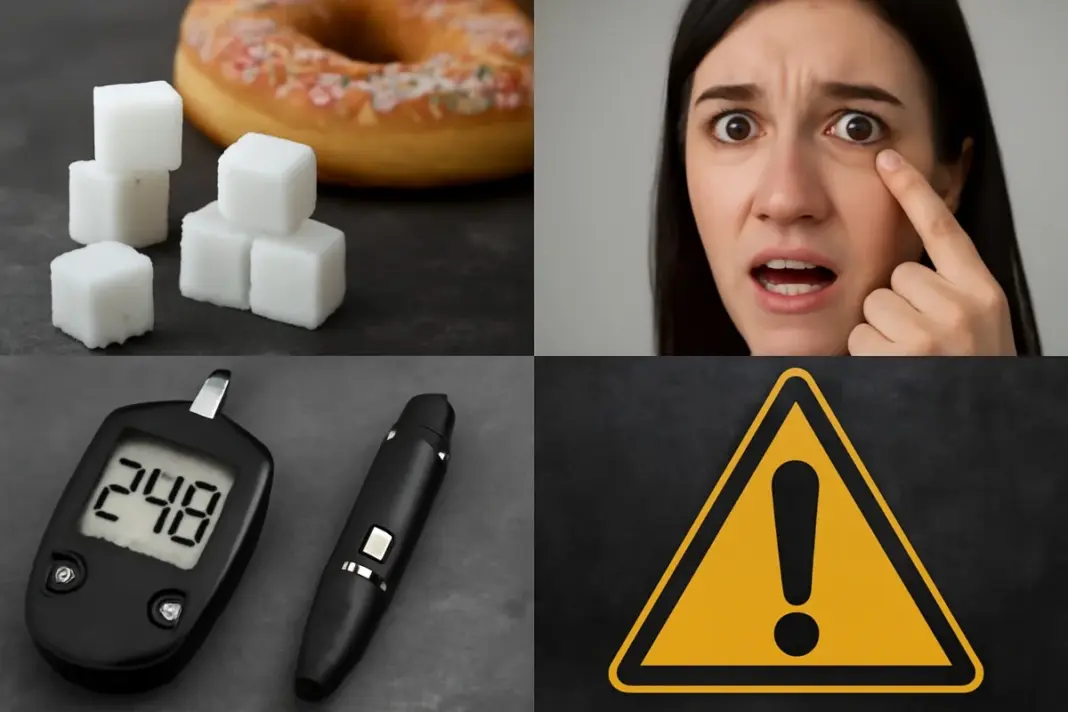A new health twist is turning heads and eyes. Experts now warn that rising blood sugar levels aren’t just a red flag for diabetics. Hidden sugar intake and its link to diabetes risk could silently trigger diabetes and vision problems, even in individuals who believe they are not at risk.
From blurred sight to permanent damage, this unseen sugar-eye connection is sparking serious concern across the health community.
Why Sugar Intake and Diabetes Risk Isn’t the Whole Story?
Many believe that only people with diabetes must limit sugar intake and worry about their blood sugar. Yet experts clarify that eating sugar alone doesn’t directly cause diabetes, though persistent high sugar intake may contribute. According to a clip shared by Sugar Watchers, the expert emphasises: “people don’t get diabetes just because they have sugar. Diabetes increases due to sugar, lifestyle and food choices.”
Daily food choices, lack of exercise, and genetic risk together shift the balance, raising sugar intake and diabetes risk for many. Managing blood sugar, making smart food choices and controlling sugar intake all help reduce sugar intake and diabetes risk even for non-diabetics.
The Alarming Link Between Diabetes and Vision Problems
When you live with high blood sugar, the damage doesn’t stop at your numbers; it creeps into your eyes. Elevated blood sugar damages tiny blood vessels at the back of the eye (the retina), leading to conditions like Diabetic Retinopathy and other threats to vision.
According to Vision Science Academy, this micro-vessel damage may begin silently and later cause blurred vision, floaters, swelling of the eye’s lens, or even permanent vision loss. That means poor blood sugar control, unchecked sugar intake, and diabetes risk combine to raise your risk of vision problems.
Foods Quietly Fueling Eye and Blood Sugar Damage
It’s not just desserts. Many everyday foods hide sugars and carbs that raise your blood sugar and feed the chain from sugar intake and diabetes risk to vision damage. Think of sweetened coffee, packaged snacks, sauces, and even “healthy” looking foods. These hidden sugars raise blood sugar levels repeatedly, worsening high blood sugar and eye health.
Over time, the repeated sugar spikes and elevated blood sugar increase your odds of diabetes and vision problems, even if you haven’t been diagnosed with diabetes. Be vigilant about reading labels, reducing processed sweets, and limiting sugary drinks to protect both your blood sugar and eye health.
See Clearly Again: Smart Fixes to Cut Sugar and Protect Vision
The good news: you can slow or stop the path from high sugar intake to blood sugar spikes, and reduce your risk of diabetes and vision problems. First, cut back on refined sugar, avoid sugary drinks, and switch to whole foods so your sugar intake and diabetes risk drop. Then pay attention to your blood sugar levels regularly. Add daily physical activity, choose low-GI foods, and keep portions in check.
Also, book a dilated eye exam each year, because safeguarding high blood sugar and eye health means catching early damage before vision problems set in. These steps together help you maintain better control of blood sugar, reduce sugar intake and diabetes risk, and protect your vision.
Sugar might seem harmless, but its impact on blood sugar and vision runs deeper than you realise. Pay attention to your intake and protect your eye health.
Disclaimer: This content, including advice, provides general information only. It is not a substitute for a qualified medical opinion in any way. The methods and claims mentioned in this article should be considered as suggestions only; DNP India neither confirms nor denies them. Always consult a doctor before following any such suggestions/treatments/medications/diets.


